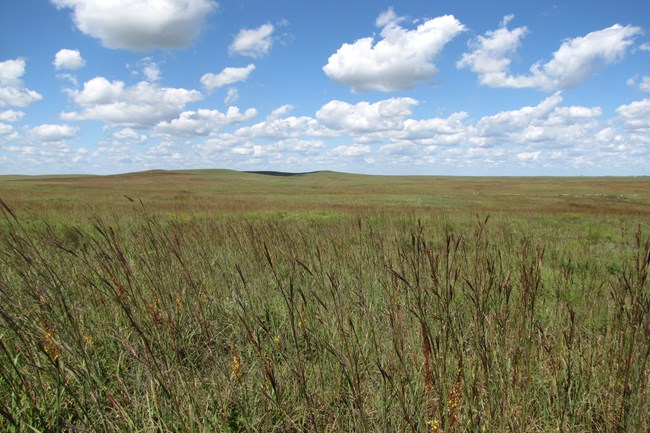
NPS Photo "Whenever you stop on the prairie to lunch or camp, and gaze around, D.W. Wilder, editor of the Hiawatha World, 1884 By 1884, D.W. Wilder was already seeing the loss of the prairie. The idea of preserving the prairie as a national park appeared as early as 1832. Painter George Catlin, who spent time with Native Americans in the northern Great Plains said there should be a “nation’s park, containing man and beast, in all the wild and freshness of their nature's beauty!" Scientists understood in the 1920’s that very little of the native prairie was left undisturbed in its natural condition. Victor E. Shelford, of the University of Illinois, and the National Research Council's Committee of the Ecology of North American Grasslands identified four sites on the Great Plains with sufficient diversity of native grassland plants to be considered true prairie. In 1930, he proposed incorporating one of them into the National Park System. The idea of a prairie park persisted through the Great Depression and World War II. Various groups proposed various forms through the 1950s, 1960s, 1970s, 1980s, and into 1990s, when H.R. 2369 was introduced in the U.S. House of Representatives in 1991. The bill would create a tallgrass prairie park from the 10,894-acre Spring Hill/Z Bar Ranch in the Flint Hills of Kansas. Representatives of National Park Trust, National Audubon Society; the Flint Hills National Monument Committee, which drafted the bill; as well as Dr. David Hartnett, associate professor of biology at Kansas State University; and Dr. Sid Stevenson, assistant professor of recreation and park management at Kansas State University testified before Congress in support of H.R. 2369. At that time and in that place, Federal ownership of that amount of land was controversial. From 1991-1994, U.S. Senator Nancy Kassebaum convened a group of stakeholders, many with opposing views, to seek agreement on the formula for a tallgrass prairie park. In January 1992 Senator Kassebaum convened the group and a different model for a national park emerged: the conditions of the park’s creation would mirror those in the previous legislation. However, it would be a public/private partnership: publicly managed land by the National Park Service, but privately owned land. The Z Bar Ranch was for sale by the Boatmen's National Bank of Kansas City, but Kassebaum’s group was unable to negotiate a sale in 1992. In June 1994, the National Park Trust was able to arrange the purchase of the Spring Hill/Z Bar Ranch, to assist in the creation of the Tallgrass Prairie National Preserve. In 1994, Senators Nancy Kassebaum-Baker and Bob Dole introduced Senate bill S. 2412 Congress, which would allow the Federal government to create a national preserve. Under the bill, the National Park Service would own no more than 180 acres of the preserve, leaving the majority of the preserve’s land in private, non-profit ownership. On November 12, 1996, the 10,894-acre Tallgrass Prairie National Preserve was created as the 370th national park unit under Public Law 104-333. 1 At the preserve’s dedication, Senator Kassebaum-Baker called the preserve a “model for the nation.” In September 2002, the National Park Trust donated 32 acres to the NPS. For nine additional years, the National Park Trust and National Park Service planned and developed the park. In April 2005, the National Park Trust completed its mission at the preserve by transferring its land ownership to The Nature Conservancy, which now works closely with the National Park Service on a wide range of tallgrass prairie restoration projects. The Kansas Park Trust assisted in the transfer of preserve property from the National Park Trust to The Nature Conservancy. Today, the NPS and The Nature Conservancy work toward preservation of the tallgrass prairie, while sharing the story of ranching legacy, American Indian history, and the diverse tallgrass prairie ecosystem here in the heart of the scenic Flint Hills of Kansas.2 1 Rebecca Conard, Principal Investigator, Susan Hess, Research Assistant, Tallgrass Historians L.C.: “Tallgrass Prairie National Preserve Legislative History, 1920-1996,” (for National Park Service Midwest Support Office, Omaha, Nebraska, 1998) 2 Tallgrass Prairie National Preserve Quick Facts, Tallgrass Prairie National Preserve, 2014 |
Last updated: February 20, 2022
